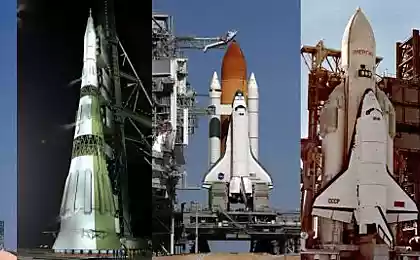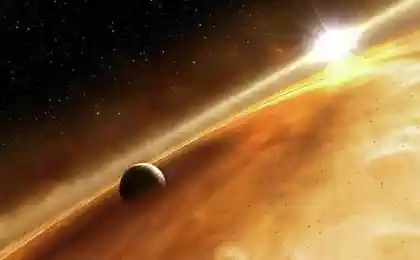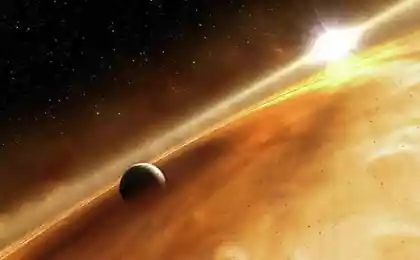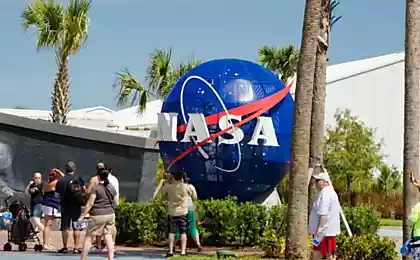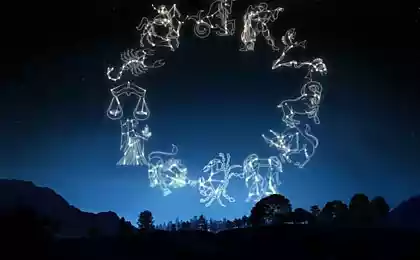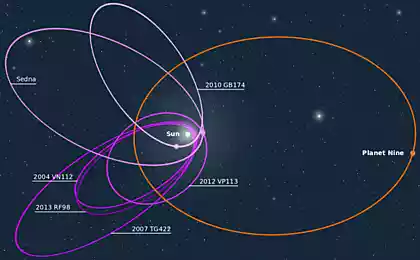864
Planet Saturn (10 photos)
Apparatus "Cassini", orbiting Saturn since 2004, continues to study the gas giant and its complex system consisting of thousands of rings and several dozen satellites. In October, he made another closer to Enceladus, one of the most interesting satellites in the Solar System. This time he flew less than 100 kilometers above the southern hemisphere. This was done in order to "Cassini" could use all the "heavy artillery" Spectrometers for geysers in the icy satellite faults. But the general public perepalo some great pictures of this satellite.
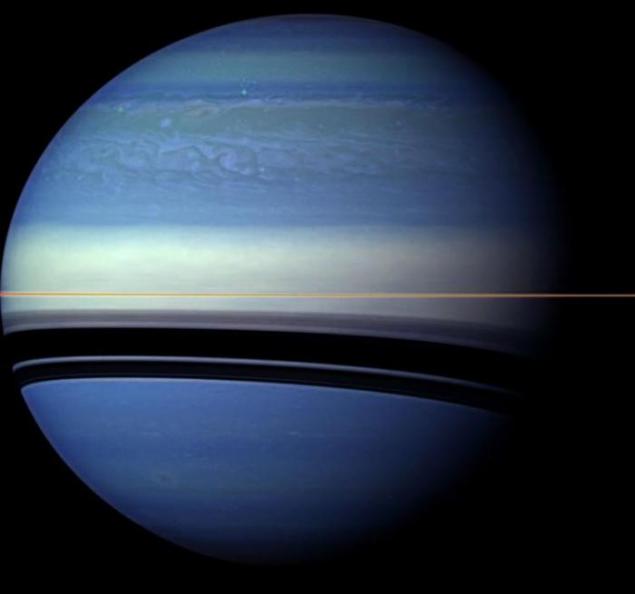
Infrared image of Saturn in false color. Sometimes pictures of space objects are painted with artificial flowers to increase the contrast of details. This was done with this image, obtained "Cassini" October 6, 2011. Due to the special treatment we can see many details in the atmosphere of Saturn
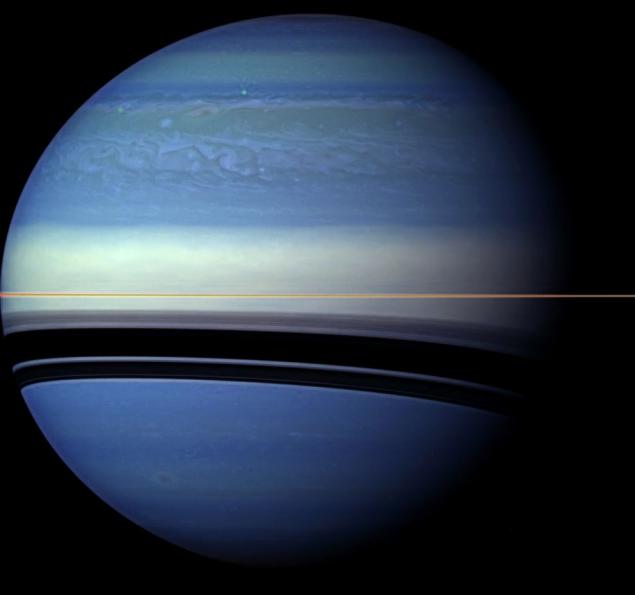
Enceladus. In this photo visible southern regions of the satellite (35 degrees south latitude, 45 degrees west longitude). Enceladus - one of the most geologically active satellites in the Solar System. Scientists suggest the existence of liquid water ocean beneath the icy, mottled bark cracks and fissures of the satellite. In this image, received on 13 September 2011, Enceladus appeared from a distance of only 42,000 km.

Saturn's moon. Enceladus and Tethys, two fairly large moon of Saturn, came in sight of the cameras, "Cassini" September 13, 2011. Tethys satellite is visible at the bottom of the picture. It seems that the Tethys is in the foreground. This is indeed the case: at the time of the shooting distance from the Tethys was 208,000 km, while Enceladus - 272000 km. Tethys and Enceladus twice the size, 1,062 km against 504. The rings of Saturn create, as always, a unique atmosphere.
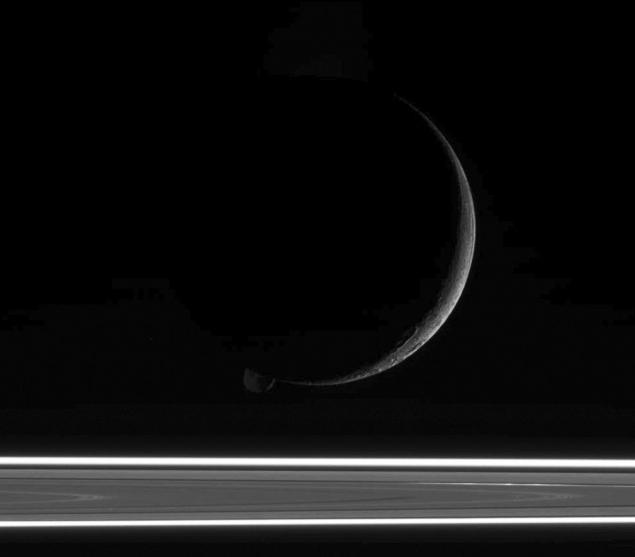
During the flyby of Enceladus on October 1 "Cassini" witnessed a curious picture. Small moon of Saturn Helen leaned out of Enceladus appears as a thin crescent. Rings give this film an incredible lightness. I must say that "Cassini" often finds a picture like this. Saturn more than six dozen satellites, and therefore it is not surprising that from time to time they hide for each other.
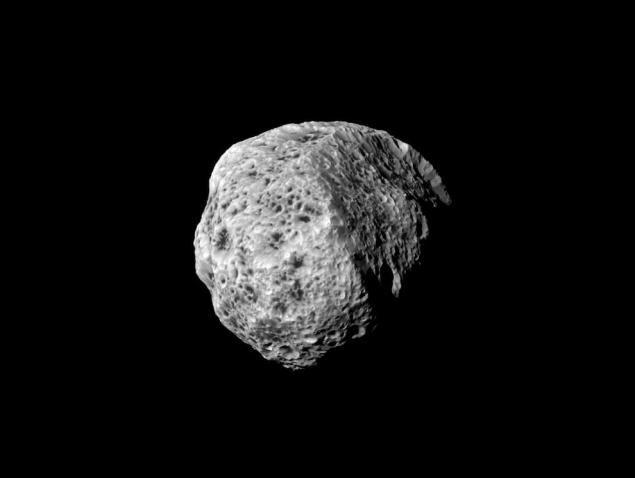
Hyperion. September 16 probe "Cassini" flew past one of the strangest moons of Saturn, Hyperion. The surface of the small (only 270 miles in diameter) of the satellite similar to the sponge. Another feature of Hyperion is its chaotic rotation around its own axis. Because of this, difficult to predict in advance which part of the satellite cameras turn to "Cassini" during their regular convergence.
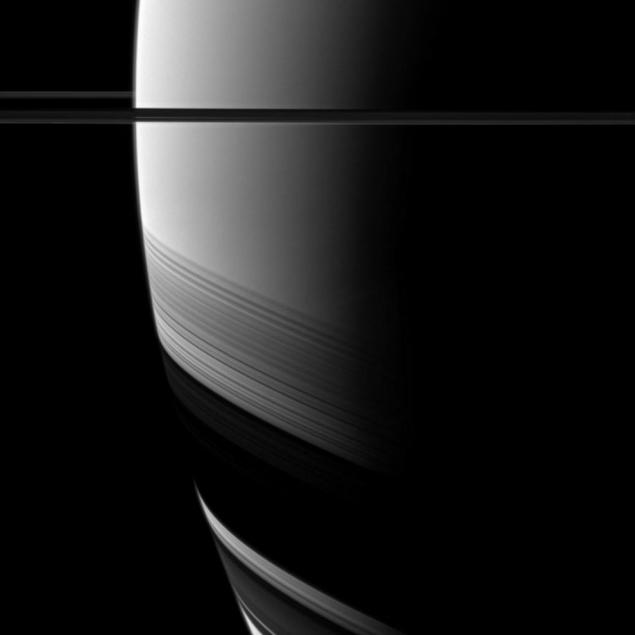
The shadows of the rings. After the equinox, which was on Saturn in 2009, the gas giant beginning of spring. The shadows of the rings with each month are becoming wider and creeping farther south. This image obtained by wide-angle camera spacecraft "Cassini" August 22, 2011, when the probe is slightly above the ring plane. Survey was conducted in the near-infrared light (wavelength - 939 nm) from a distance of 405 thousand. Kilometers.
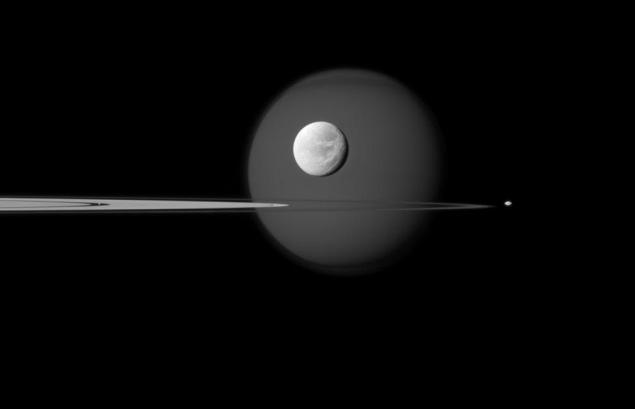
Just four moons of Saturn are seen in this picture, "Cassini". The largest moon, Titan, with a diameter 5150 km enveloped dense atmosphere. Dion is slightly elevated above the plane of the rings; compared with the hazy Titan Dione enough bright object. Other two satellites have got this picture, rotate in the plane of Saturn's rings. Pandora is a small (to the right of the Rings) in diameter of 81 km and very tiny Pan diameter of 28 km. It can be found in the Encke gap left in the picture. Pan and Pandora - satellites shepherds. They seem to "graze" particles of Saturn's rings, not allowing them to go to the side.
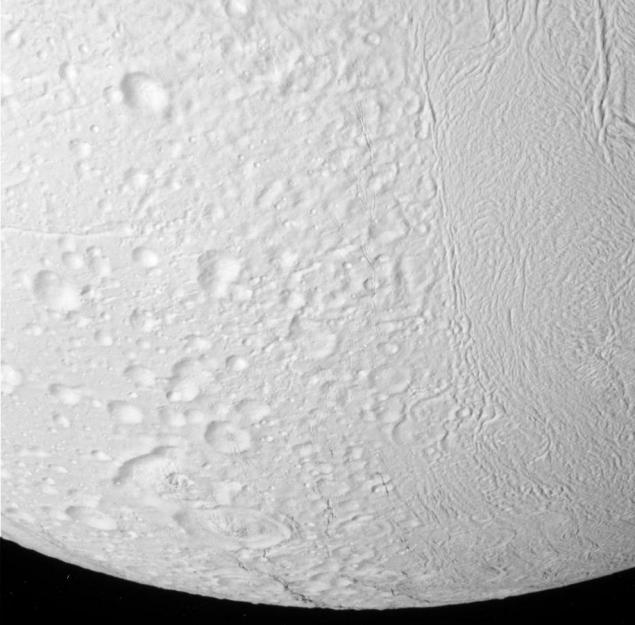
October 1, 2011 "Cassini" was just 62 kilometers above the surface of Enceladus and sent to Earth a series of photographs of this highly interesting companion. Many raw photos taken "Cassini" processed amateur astronomers, and then there are freely available on the Internet. This is - one of those pictures.
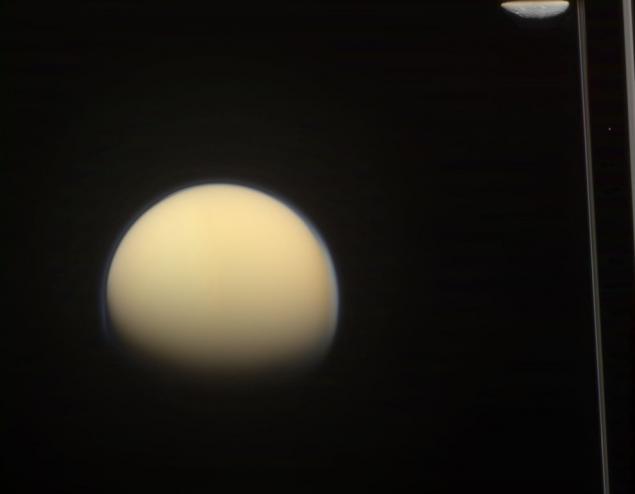
Titan and Dione behind the limb of Saturn. Picture was taken October 18, 2011 the spacecraft "Cassini". At the time of the shooting distance to Titan was 2, 58 million kilometers. In the lens of the camera also got a bright star that can be seen between the rings of Saturn.
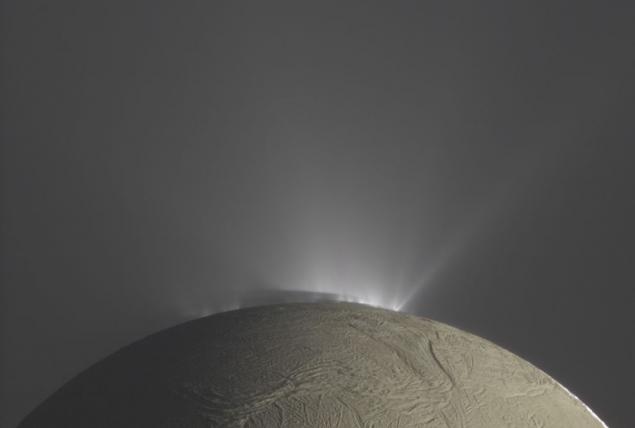
On Enceladus. Picture of Enceladus's south pole was obtained apparatus almost a year ago, on November 30, 2011. But last month he was treated and painted. Opens before us a fantastic view: sunlit jet gases rise to hundreds of kilometers above the icy surface. Remotely similar to the beams of searchlights jet - the result kriovulkanicheskoy activity on the surface of Enceladus. This water is a real water under pressure escapes from cracks in the ice cover of the satellite.
Source

Infrared image of Saturn in false color. Sometimes pictures of space objects are painted with artificial flowers to increase the contrast of details. This was done with this image, obtained "Cassini" October 6, 2011. Due to the special treatment we can see many details in the atmosphere of Saturn

Enceladus. In this photo visible southern regions of the satellite (35 degrees south latitude, 45 degrees west longitude). Enceladus - one of the most geologically active satellites in the Solar System. Scientists suggest the existence of liquid water ocean beneath the icy, mottled bark cracks and fissures of the satellite. In this image, received on 13 September 2011, Enceladus appeared from a distance of only 42,000 km.

Saturn's moon. Enceladus and Tethys, two fairly large moon of Saturn, came in sight of the cameras, "Cassini" September 13, 2011. Tethys satellite is visible at the bottom of the picture. It seems that the Tethys is in the foreground. This is indeed the case: at the time of the shooting distance from the Tethys was 208,000 km, while Enceladus - 272000 km. Tethys and Enceladus twice the size, 1,062 km against 504. The rings of Saturn create, as always, a unique atmosphere.

During the flyby of Enceladus on October 1 "Cassini" witnessed a curious picture. Small moon of Saturn Helen leaned out of Enceladus appears as a thin crescent. Rings give this film an incredible lightness. I must say that "Cassini" often finds a picture like this. Saturn more than six dozen satellites, and therefore it is not surprising that from time to time they hide for each other.

Hyperion. September 16 probe "Cassini" flew past one of the strangest moons of Saturn, Hyperion. The surface of the small (only 270 miles in diameter) of the satellite similar to the sponge. Another feature of Hyperion is its chaotic rotation around its own axis. Because of this, difficult to predict in advance which part of the satellite cameras turn to "Cassini" during their regular convergence.

The shadows of the rings. After the equinox, which was on Saturn in 2009, the gas giant beginning of spring. The shadows of the rings with each month are becoming wider and creeping farther south. This image obtained by wide-angle camera spacecraft "Cassini" August 22, 2011, when the probe is slightly above the ring plane. Survey was conducted in the near-infrared light (wavelength - 939 nm) from a distance of 405 thousand. Kilometers.

Just four moons of Saturn are seen in this picture, "Cassini". The largest moon, Titan, with a diameter 5150 km enveloped dense atmosphere. Dion is slightly elevated above the plane of the rings; compared with the hazy Titan Dione enough bright object. Other two satellites have got this picture, rotate in the plane of Saturn's rings. Pandora is a small (to the right of the Rings) in diameter of 81 km and very tiny Pan diameter of 28 km. It can be found in the Encke gap left in the picture. Pan and Pandora - satellites shepherds. They seem to "graze" particles of Saturn's rings, not allowing them to go to the side.

October 1, 2011 "Cassini" was just 62 kilometers above the surface of Enceladus and sent to Earth a series of photographs of this highly interesting companion. Many raw photos taken "Cassini" processed amateur astronomers, and then there are freely available on the Internet. This is - one of those pictures.

Titan and Dione behind the limb of Saturn. Picture was taken October 18, 2011 the spacecraft "Cassini". At the time of the shooting distance to Titan was 2, 58 million kilometers. In the lens of the camera also got a bright star that can be seen between the rings of Saturn.

On Enceladus. Picture of Enceladus's south pole was obtained apparatus almost a year ago, on November 30, 2011. But last month he was treated and painted. Opens before us a fantastic view: sunlit jet gases rise to hundreds of kilometers above the icy surface. Remotely similar to the beams of searchlights jet - the result kriovulkanicheskoy activity on the surface of Enceladus. This water is a real water under pressure escapes from cracks in the ice cover of the satellite.
Source





